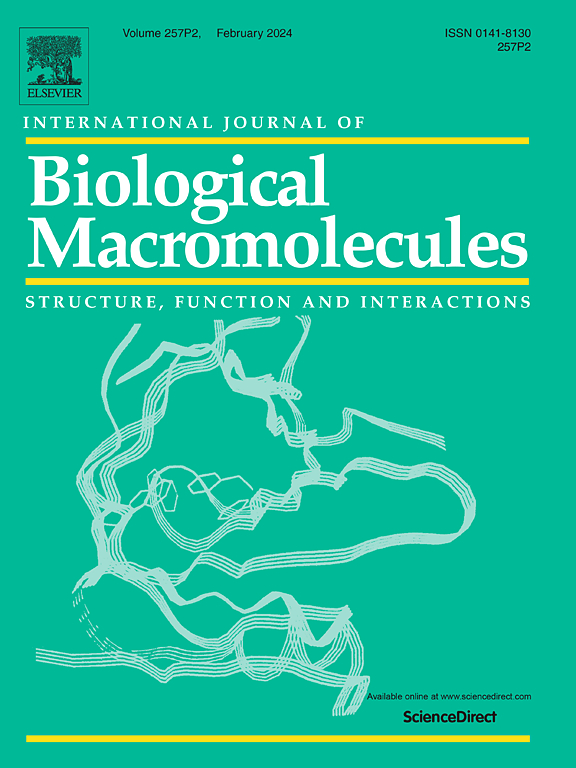Design and synthesis of a new recyclable nanohydrogel based on chitosan for Deltamethrin removal from aqueous solutions: Optimization and modeling by RSM-ANN
IF 7.7
1区 化学
Q1 BIOCHEMISTRY & MOLECULAR BIOLOGY
International Journal of Biological Macromolecules
Pub Date : 2024-12-01
DOI:10.1016/j.ijbiomac.2024.137921
引用次数: 0
Abstract
In this study, a new magnetic biocompatible hydrogel was synthesized as an adsorbent for Deltamethrin pesticide removal. The optimal conditions and adsorption process of Deltamethrin by chitosan/polyacrylic acid/Fe3O4 nanocomposite hydrogel was studied by Response Surface Methodology by Central Composite Design (RSM-CCD) and Artificial Neural Network (ANN). This adsorbents were synthesized, and then characterized and investigated using FT-IR, XRD, FE-SEM, EDX, Map, VSM, and TGA methods. The results of these analyses showed that the nanocomposite hydrogel was well synthesized and has the ability to adsorb the Deltamethrin pesticide. The results obtained through analysis using response surface methodology showed that the maximum amount of adsorption was 99.79 % at 26 °C, while pH, initial concentration, contact time, and adsorbent dose were 7, 22 ppm, 90 min, and 1.3 g/L respectively. Comparison between results obtained from CCD modeling and artificial neural network proved that both methods had high ability to predict the adsorption process but the CCD method had higher coefficient of determination and lower error. The equilibrium and kinetic study of the process showed that the Toth isotherm model, pseudo-second-order is all suitable for expressing the adsorption process. In addition, the adsorption mechanism followed double-exponential model that combines external and internal diffusions. Results of Thermodynamic study suggested that the Deltamethrin adsorption on CS/PAA/Fe3O4 was a spontaneous and exothermic process. The results of the equilibrium process study revealed that the adsorption process was physical and desirable, therefore, the adsorption-desorption process was performed which showed that the composite was reusable up to 10 cycles.
设计和合成一种基于壳聚糖的新型可回收纳米水凝胶,用于去除水溶液中的溴氰菊酯:利用 RSM-ANN 进行优化和建模。
本研究合成了一种新型磁性生物相容性水凝胶,作为去除溴氰菊酯农药的吸附剂。采用响应面方法学-中央复合设计(RSM-CCD)和人工神经网络(ANN)研究了壳聚糖/聚丙烯酸/Fe3O4 纳米复合水凝胶对溴氰菊酯的最佳吸附条件和吸附过程。合成了这种吸附剂,然后使用 FT-IR、XRD、FE-SEM、EDX、Map、VSM 和 TGA 方法对其进行了表征和研究。这些分析结果表明,纳米复合水凝胶合成良好,具有吸附溴氰菊酯农药的能力。利用响应面方法进行分析得出的结果表明,在 26 °C 时,吸附量最大为 99.79%,pH 值、初始浓度、接触时间和吸附剂剂量分别为 7、22 ppm、90 分钟和 1.3 g/L。比较 CCD 建模和人工神经网络得出的结果证明,两种方法都具有很高的预测吸附过程的能力,但 CCD 方法的确定系数更高,误差更小。吸附过程的平衡和动力学研究表明,Toth 等温线模型、伪二阶模型都适合表达吸附过程。此外,吸附机理遵循外部扩散和内部扩散相结合的双指数模型。热力学研究结果表明,溴氰菊酯在 CS/PAA/Fe3O4 上的吸附是一个自发的放热过程。平衡过程研究的结果表明,吸附过程是物理的和理想的,因此进行了吸附-解吸过程,结果表明该复合材料可重复使用达 10 个周期。
本文章由计算机程序翻译,如有差异,请以英文原文为准。
求助全文
约1分钟内获得全文
求助全文
来源期刊
CiteScore
13.70
自引率
9.80%
发文量
2728
审稿时长
64 days
期刊介绍:
The International Journal of Biological Macromolecules is a well-established international journal dedicated to research on the chemical and biological aspects of natural macromolecules. Focusing on proteins, macromolecular carbohydrates, glycoproteins, proteoglycans, lignins, biological poly-acids, and nucleic acids, the journal presents the latest findings in molecular structure, properties, biological activities, interactions, modifications, and functional properties. Papers must offer new and novel insights, encompassing related model systems, structural conformational studies, theoretical developments, and analytical techniques. Each paper is required to primarily focus on at least one named biological macromolecule, reflected in the title, abstract, and text.

 求助内容:
求助内容: 应助结果提醒方式:
应助结果提醒方式:


